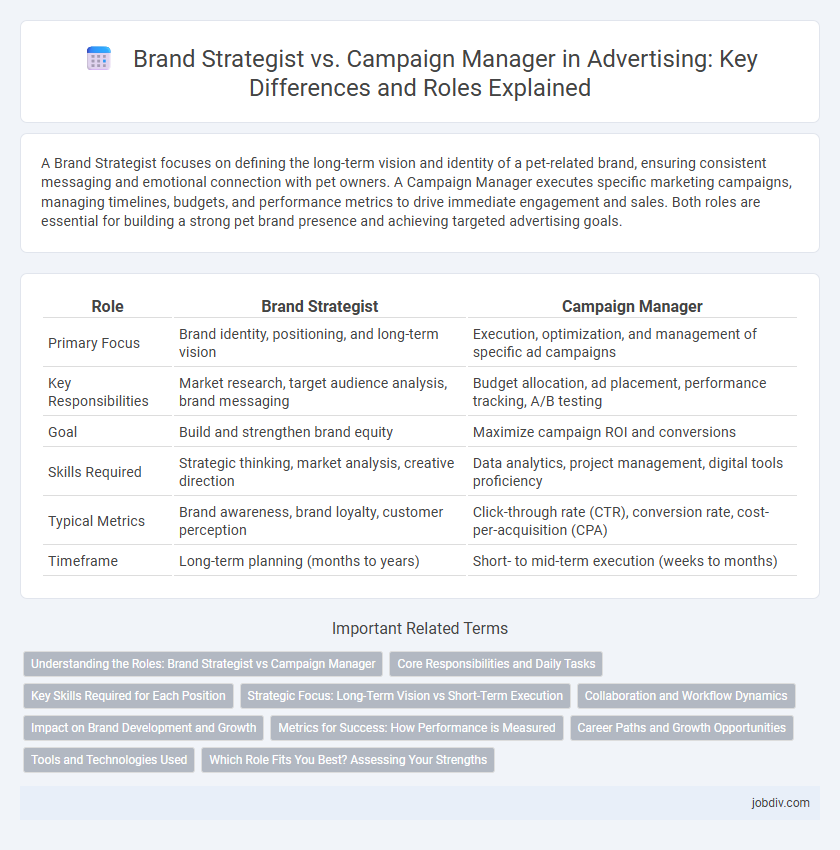A Brand Strategist focuses on defining the long-term vision and identity of a pet-related brand, ensuring consistent messaging and emotional connection with pet owners. A Campaign Manager executes specific marketing campaigns, managing timelines, budgets, and performance metrics to drive immediate engagement and sales. Both roles are essential for building a strong pet brand presence and achieving targeted advertising goals.
Table of Comparison
| Role | Brand Strategist | Campaign Manager |
|---|---|---|
| Primary Focus | Brand identity, positioning, and long-term vision | Execution, optimization, and management of specific ad campaigns |
| Key Responsibilities | Market research, target audience analysis, brand messaging | Budget allocation, ad placement, performance tracking, A/B testing |
| Goal | Build and strengthen brand equity | Maximize campaign ROI and conversions |
| Skills Required | Strategic thinking, market analysis, creative direction | Data analytics, project management, digital tools proficiency |
| Typical Metrics | Brand awareness, brand loyalty, customer perception | Click-through rate (CTR), conversion rate, cost-per-acquisition (CPA) |
| Timeframe | Long-term planning (months to years) | Short- to mid-term execution (weeks to months) |
Understanding the Roles: Brand Strategist vs Campaign Manager
A Brand Strategist develops long-term brand positioning by analyzing market trends, consumer behavior, and competitive landscapes to create a cohesive identity that drives brand equity. In contrast, a Campaign Manager focuses on executing specific promotional activities, managing timelines, budgets, and metrics to optimize campaign performance and achieve measurable marketing goals. Understanding these distinct roles ensures effective collaboration and maximizes advertising impact.
Core Responsibilities and Daily Tasks
Brand strategists focus on developing long-term brand positioning and messaging frameworks to build brand equity, while campaign managers execute specific marketing campaigns to drive short-term sales and engagement. Core responsibilities of brand strategists include market research, competitor analysis, and defining target audience personas, whereas campaign managers handle media planning, budget allocation, and performance tracking. Daily tasks for brand strategists involve collaborating with creative teams to ensure consistent brand voice, while campaign managers coordinate with vendors and analyze campaign metrics to optimize results.
Key Skills Required for Each Position
Brand Strategists excel in market research, consumer behavior analysis, and long-term brand positioning to create cohesive identity frameworks. Campaign Managers specialize in project management, digital marketing tools, and campaign execution to ensure timely delivery and measurable performance. Both roles demand strong communication, analytical thinking, and collaboration skills to drive successful advertising outcomes.
Strategic Focus: Long-Term Vision vs Short-Term Execution
A Brand Strategist directs long-term vision by defining core brand values, market positioning, and growth opportunities to ensure sustained brand equity over time. In contrast, a Campaign Manager focuses on short-term execution by coordinating specific advertising initiatives, managing budgets, and optimizing campaign performance for immediate results. The strategic focus distinguishes the Brand Strategist's role in shaping overarching brand identity from the Campaign Manager's emphasis on tactical implementation and measurable outcomes.
Collaboration and Workflow Dynamics
Brand Strategists and Campaign Managers collaborate closely to ensure cohesive advertising efforts, with strategists focusing on long-term brand positioning and campaign managers overseeing the execution of marketing initiatives. Workflow dynamics involve the Brand Strategist developing overarching brand messages and insights, which the Campaign Manager translates into targeted campaigns, managing timelines, budgets, and media channels. Effective communication between these roles enhances campaign alignment with brand goals, driving consistent audience engagement and maximizing advertising ROI.
Impact on Brand Development and Growth
A Brand Strategist drives long-term brand development by defining core values, market positioning, and customer perception, which cultivates brand loyalty and sustainable growth. A Campaign Manager implements targeted marketing initiatives, optimizing short-term engagement and sales performance through data-driven execution. Together, their roles ensure cohesive brand messaging while accelerating both brand equity and market expansion.
Metrics for Success: How Performance is Measured
Brand Strategists measure success through brand equity metrics such as brand awareness, perception, and long-term customer loyalty, focusing on overall market positioning and growth. Campaign Managers track performance via immediate metrics like click-through rates (CTR), conversion rates, return on ad spend (ROAS), and engagement levels to optimize ongoing campaigns. Both roles rely on data analytics tools but prioritize different KPIs that align with brand development versus campaign execution.
Career Paths and Growth Opportunities
Brand strategists focus on developing long-term brand positioning and market identity, driving overall business growth through strategic insights and consumer research. Campaign managers specialize in executing targeted marketing campaigns, optimizing performance metrics, and managing budgets for short-term promotional success. Career growth for brand strategists often leads to roles like Chief Marketing Officer (CMO) or Brand Director, while campaign managers can advance to senior project management or marketing operations leadership.
Tools and Technologies Used
Brand strategists utilize data analytics platforms like Google Analytics and consumer insight tools such as Qualtrics to craft long-term brand positioning and market segmentation strategies. Campaign managers rely on project management software like Asana or Trello, along with digital advertising platforms including Facebook Ads Manager and Google Ads, to execute and optimize advertising campaigns in real time. Both roles increasingly incorporate AI-powered tools for audience targeting and performance tracking to enhance campaign effectiveness and brand consistency.
Which Role Fits You Best? Assessing Your Strengths
Brand strategists excel in long-term vision and market positioning, making them ideal for those who thrive on big-picture thinking and deep consumer insights. Campaign managers suit individuals who are detail-oriented, enjoy managing timelines, and excel in coordinating cross-functional teams to execute marketing initiatives. Assessing your strengths in creativity, leadership, and project management helps determine whether you align better with strategic brand development or tactical campaign delivery.
Brand Strategist vs Campaign Manager Infographic

 jobdiv.com
jobdiv.com